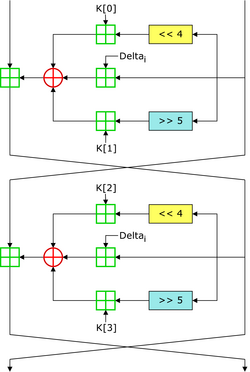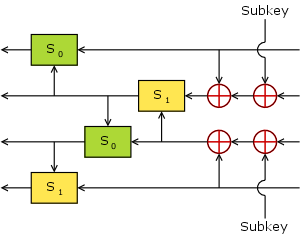Related Research Articles

The Data Encryption Standard is a symmetric-key algorithm for the encryption of digital data. Although its short key length of 56 bits makes it too insecure for modern applications, it has been highly influential in the advancement of cryptography.
Differential cryptanalysis is a general form of cryptanalysis applicable primarily to block ciphers, but also to stream ciphers and cryptographic hash functions. In the broadest sense, it is the study of how differences in information input can affect the resultant difference at the output. In the case of a block cipher, it refers to a set of techniques for tracing differences through the network of transformation, discovering where the cipher exhibits non-random behavior, and exploiting such properties to recover the secret key.

Eli Biham is an Israeli cryptographer and cryptanalyst who is a professor at the Technion - Israel Institute of Technology Computer Science department. From 2008 to 2013, Biham was the dean of the Technion Computer Science department, after serving for two years as chief of CS graduate school. Biham invented (publicly) differential cryptanalysis, for which he received his Ph.D., while working under Adi Shamir. It had been invented before by a team at IBM during their Data Encryption Standard work; the National Security Agency told IBM to keep the discovery secret.
In cryptography, Skipjack is a block cipher—an algorithm for encryption—developed by the U.S. National Security Agency (NSA). Initially classified, it was originally intended for use in the controversial Clipper chip. Subsequently, the algorithm was declassified.

In cryptography, the Tiny Encryption Algorithm (TEA) is a block cipher notable for its simplicity of description and implementation, typically a few lines of code. It was designed by David Wheeler and Roger Needham of the Cambridge Computer Laboratory; it was first presented at the Fast Software Encryption workshop in Leuven in 1994, and first published in the proceedings of that workshop.

In cryptography, FEAL is a block cipher proposed as an alternative to the Data Encryption Standard (DES), and designed to be much faster in software. The Feistel based algorithm was first published in 1987 by Akihiro Shimizu and Shoji Miyaguchi from NTT. The cipher is susceptible to various forms of cryptanalysis, and has acted as a catalyst in the discovery of differential and linear cryptanalysis.
In cryptography, MAGENTA is a symmetric key block cipher developed by Michael Jacobson Jr. and Klaus Huber for Deutsche Telekom. The name MAGENTA is an acronym for Multifunctional Algorithm for General-purpose Encryption and Network Telecommunication Applications. The cipher was submitted to the Advanced Encryption Standard process, but did not advance beyond the first round; cryptographic weaknesses were discovered and it was found to be one of the slower ciphers submitted.
In cryptography, Khufu and Khafre are two block ciphers designed by Ralph Merkle in 1989 while working at Xerox's Palo Alto Research Center. Along with Snefru, a cryptographic hash function, the ciphers were named after the Egyptian Pharaohs Khufu, Khafre and Sneferu.
In cryptography, the eXtended Sparse Linearization (XSL) attack is a method of cryptanalysis for block ciphers. The attack was first published in 2002 by researchers Nicolas Courtois and Josef Pieprzyk. It has caused some controversy as it was claimed to have the potential to break the Advanced Encryption Standard (AES) cipher, also known as Rijndael, faster than an exhaustive search. Since AES is already widely used in commerce and government for the transmission of secret information, finding a technique that can shorten the amount of time it takes to retrieve the secret message without having the key could have wide implications.
In cryptography, REDOC II and REDOC III are block ciphers designed by Michael Wood (cryptographer) for Cryptech Inc and are optimised for use in software. Both REDOC ciphers are patented.

In cryptography, the boomerang attack is a method for the cryptanalysis of block ciphers based on differential cryptanalysis. The attack was published in 1999 by David Wagner, who used it to break the COCONUT98 cipher.
Introduced by Martin Hellman and Susan K. Langford in 1994, the differential-linear attack is a mix of both linear cryptanalysis and differential cryptanalysis.
In cryptography, integral cryptanalysis is a cryptanalytic attack that is particularly applicable to block ciphers based on substitution–permutation networks. It was originally designed by Lars Knudsen as a dedicated attack against Square, so it is commonly known as the Square attack. It was also extended to a few other ciphers related to Square: CRYPTON, Rijndael, and SHARK. Stefan Lucks generalized the attack to what he called a saturation attack and used it to attack Twofish, which is not at all similar to Square, having a radically different Feistel network structure. Forms of integral cryptanalysis have since been applied to a variety of ciphers, including Hierocrypt, IDEA, Camellia, Skipjack, MISTY1, MISTY2, SAFER++, KHAZAD, and FOX.
Alex Biryukov is a cryptographer, currently a full professor at the University of Luxembourg. His notable work includes the design of the stream cipher LEX, as well as the cryptanalysis of numerous cryptographic primitives. In 1998, he developed impossible differential cryptanalysis together with Eli Biham and Adi Shamir. In 1999, he developed the slide attack together with David Wagner. In 2009 he developed, together with Dmitry Khovratovich, the first cryptanalytic attack on full-round AES-192 and AES-256 that is faster than a brute-force attack. In 2015 he developed the Argon2 key derivation function with Daniel Dinu and Dmitry Khovratovich. Since 1994 Alex Biryukov is a member of the International Association for Cryptologic Research.
In cryptography, COCONUT98 is a block cipher designed by Serge Vaudenay in 1998. It was one of the first concrete applications of Vaudenay's decorrelation theory, designed to be provably secure against differential cryptanalysis, linear cryptanalysis, and even certain types of undiscovered cryptanalytic attacks.
In cryptography, truncated differential cryptanalysis is a generalization of differential cryptanalysis, an attack against block ciphers. Lars Knudsen developed the technique in 1994. Whereas ordinary differential cryptanalysis analyzes the full difference between two texts, the truncated variant considers differences that are only partially determined. That is, the attack makes predictions of only some of the bits instead of the full block. This technique has been applied to SAFER, IDEA, Skipjack, E2, Twofish, Camellia, CRYPTON, and even the stream cipher Salsa20.
In cryptography, partitioning cryptanalysis is a form of cryptanalysis for block ciphers. Developed by Carlo Harpes in 1995, the attack is a generalization of linear cryptanalysis. Harpes originally replaced the bit sums of linear cryptanalysis with more general balanced Boolean functions. He demonstrated a toy cipher that exhibits resistance against ordinary linear cryptanalysis but is susceptible to this sort of partitioning cryptanalysis. In its full generality, partitioning cryptanalysis works by dividing the sets of possible plaintexts and ciphertexts into efficiently-computable partitions such that the distribution of ciphertexts is significantly non-uniform when the plaintexts are chosen uniformly from a given block of the partition. Partitioning cryptanalysis has been shown to be more effective than linear cryptanalysis against variants of DES and CRYPTON. A specific partitioning attack called mod n cryptanalysis uses the congruence classes modulo some integer for partitions.

In cryptography, Twofish is a symmetric key block cipher with a block size of 128 bits and key sizes up to 256 bits. It was one of the five finalists of the Advanced Encryption Standard contest, but it was not selected for standardization. Twofish is related to the earlier block cipher Blowfish.
This article summarizes publicly known attacks against block ciphers and stream ciphers. Note that there are perhaps attacks that are not publicly known, and not all entries may be up to date.

Orr Dunkelman is an Israeli cryptographer and cryptanalyst, currently a professor at the University of Haifa Computer Science department. Dunkelman is a co-director of the Center for Cyber Law & Privacy at the University of Haifa and a co-founder of Privacy Israel, an Israeli NGO for promoting privacy in Israel.
References
- ↑ Lars Knudsen (February 21, 1998). "DEAL - A 128-bit Block Cipher". Technical report no. 151. Department of Informatics, University of Bergen, Norway. Retrieved 2015-05-28.
{{cite journal}}: Cite journal requires|journal=(help) - ↑ Shamir, A. (August 25, 1998) Impossible differential attacks. CRYPTO '98 rump session (video at Google Video —uses Flash)
- ↑ Biryukov, A. (August 25, 1998) Miss-in-the-middle attacks on IDEA. CRYPTO '98 rump session (video at Google Video—uses Flash)
- ↑ Biham, E. (August 25, 1998) Impossible cryptanalysis of Skipjack. CRYPTO '98 rump session (video at Google Video—uses Flash)
- ↑ Bruce Schneier (September 15, 1998). "Impossible Cryptanalysis and Skipjack". Crypto-Gram Newsletter.
- ↑ E. Biham; A. Biryukov; A. Shamir (March 1999). Miss in the Middle Attacks on IDEA, Khufu and Khafre. 6th International Workshop on Fast Software Encryption (FSE 1999). Rome: Springer-Verlag. pp. 124–138. Archived from the original (gzipped PostScript) on 2011-05-15. Retrieved 2007-02-14.